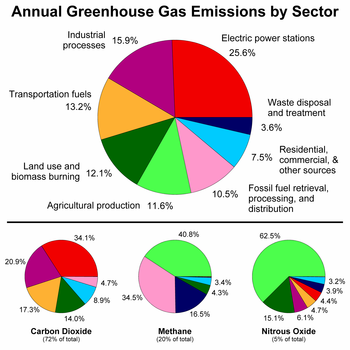 |
| Se below (Photo credit: Wikipedia) |
Today we review a report from the Pembina Institute which examined the roles provinces play and could play in reducing greenhouse gas emissions to meet national goals, a Canadian Energy Strategy – the main item discussed at a meeting Canadian premiers in Quebec City. While three provinces (Ontario, Quebec and BC) have made modest reductions of 19, 9 and 3% from 2005, Alberta now produces more than Quebec and Ontario combined with a failed cap and trade system that applies to less than 50% of its emissions at a price ($1.80 per tonne) that has little impact on decisions made by industry to reduce carbon fuel use. The plans for the Alberta oil sands and proposals to expand pipeline capacity to the east coast (by 1.1 mbpd) contribute to concerns to keep 2/3’s of the earth’s carbon reserves in the ground if the objective of limiting climate warming to less than 2 degrees C- which means that the oil sands production bust be limited by 3.3 mbpd. Restoration of a committee to advise the federal government on a Canada Energy Strategy is recommended, similar to the long standing one that was eliminated by the present government (the National Roundtable on the Environment and the Economy or NTREE)
Key Quotes:
“Between 2005 and 2012, only Alberta’s and Saskatchewan’s emissions profiles worsened in absolute terms…Alberta’s at a rate of 7% above 2005 levels, and Saskatchewan at a rate of 5% above 2005 levels”
“Ontario (19% below 2005) …Green Energy Act have contributed to the province achieving a 19% reduction below 2005 emissions levels.. phase out of coal-fired power and the successful implementation of the Green Energy Act”
“Quebec (9% below 2005)… has reduced its emissions by 6.8% below its 1990 levels… Quebec’s 2012 emissions were 9% below its 2005 levels.. Quebec remains a strong member of the Western Climate Initiative, North America’s first and largest cap-and-trade system”
“British Columbia (3% below 2005)… the carbon tax, clean energy requirements and the low-carbon fuel standard have enabled the province to meet its 2012 interim target to cut carbon pollution. In 2012, B.C. had reduced its emissions inventory by 3% relative to the province’s 2005 emissions levels”
“Alberta now produces more greenhouse gas emissions than Ontario and Quebec … Alberta’s rules apply to approximately 50% of the province's total emissions; facilities with less than100,000 tonnes of emissions per year are exempt… The effective carbon price .. is therefore well below $15 per tonne — for companies regulated by the policy, it works out to just $1.80 per tonne of emissions released.”
“Because of the Energy East pipeline’s proposed capacity of 1.1 mbpd, it could play a significant role in determining how much and how fast the oil sands sector expands…crude by rail will provide less than one-quarter of the oil sands industry’s total transportation requirement in the next 12 to 16 months”
“to ensure the planet has a 50% chance of limiting atmospheric warming to 2°C — two-thirds of the earth’s known oil, gas, and coal reserves must remain unburned between now and 2050. Tracing this back to production in Alberta’s oil sands, the IEA had modeled scenarios that include up to 3.3 mbpd of oil sands production.”
“Create a climate and energy advisory committee within the Canadian Energy Strategy…This committee would advise the premiers on the optimal path forward as they work to decarbonize their energy systems while growing their economies.”




No comments:
Post a Comment